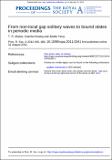From non-local gap solitary waves to bound states in periodic media
Author(s)
Akylas, Triantaphyllos R.; Hwang, Guenbo; Yang, Jianke
DownloadAkylas_From non-local.pdf (546.1Kb)
PUBLISHER_POLICY
Publisher Policy
Article is made available in accordance with the publisher's policy and may be subject to US copyright law. Please refer to the publisher's site for terms of use.
Terms of use
Metadata
Show full item recordAbstract
Solitary waves in one-dimensional periodic media are discussed by employing the nonlinear Schrödinger equation with a spatially periodic potential as a model. This equation admits two families of gap solitons that bifurcate from the edges of Bloch bands in the linear wave spectrum. These fundamental solitons may be positioned only at specific locations relative to the potential; otherwise, they become non-local owing to the presence of growing tails of exponentially small amplitude with respect to the wave peak amplitude. Here, by matching the tails of such non-local solitary waves, high-order locally confined gap solitons, or bound states, are constructed. Details are worked out for bound states comprising two non-local solitary waves in the presence of a sinusoidal potential. A countable set of bound-state families, characterized by the separation distance of the two solitary waves, is found, and each family features three distinct solution branches that bifurcate near Bloch-band edges at small, but finite, amplitude. Power curves associated with these solution branches are computed asymptotically for large solitary-wave separation, and the theoretical predictions are consistent with numerical results.
Date issued
2011-08Department
Massachusetts Institute of Technology. Department of Mechanical EngineeringJournal
Proceedings of The Royal Society A: Mathematical, Physical and Engineering Sciences
Publisher
Royal Society, The
Citation
Akylas, T. R., G. Hwang, and J. Yang. “From Non-local Gap Solitary Waves to Bound States in Periodic Media.” Proceedings of the Royal Society A: Mathematical, Physical and Engineering Sciences 468.2137 (2011): 116–135. © The Royal Society 2013
Version: Final published version
ISSN
1364-5021
1471-2946